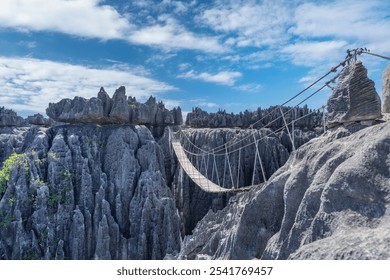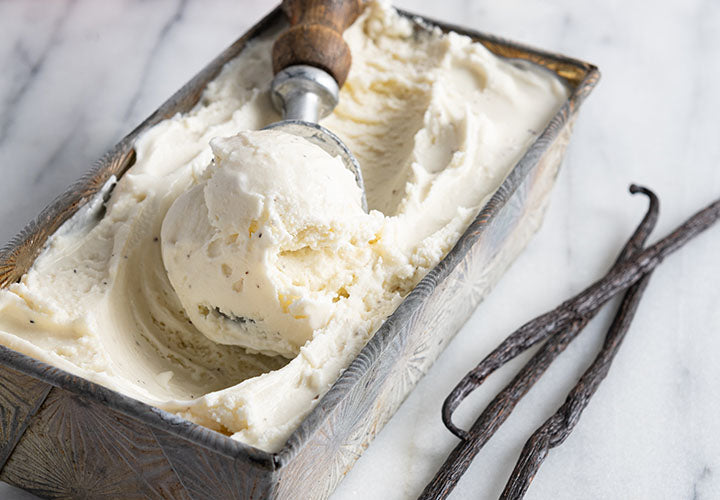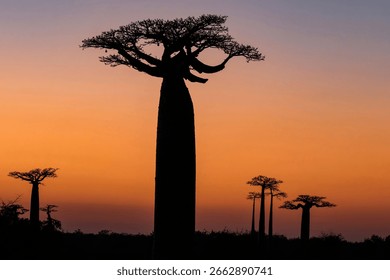Madagascar's Living Cathedrals: A Botanist's Perspective on Conservation in the Tsingy and Beyond

Imagine standing amidst a forest of razor-sharp limestone spires, bathed in the golden light of dawn, the air thick with the chirping of unseen birds. This is the Tsingy, a place where evolution has run wild, and where every step is a journey into the extraordinary. As a botanist and conservationist specializing in island flora, I, Dr. Evelyn Hayes, have dedicated my life to understanding and preserving these unique ecosystems. My recent two-week expedition to Madagascar, specifically the Tsingy de Bemaraha Strict Nature Reserve and the Avenue of the Baobabs near Morondava, was nothing short of a revelation – a powerful reminder of both the incredible biodiversity at stake and the inspiring efforts underway to protect it.
The Tsingy: A Geological and Botanical Marvel
The Tsingy de Bemaraha is unlike any place I've ever encountered. The very name "Tsingy" translates to "where one cannot walk barefoot," a fitting description for this landscape of jagged limestone karsts. Millions of years of erosion have sculpted these towering formations, creating a seemingly impenetrable fortress.
But life finds a way, even here. Specialized plants, adapted to survive on the bare rock, cling to the crevices. These lithophytic plants, as we call them, are a testament to the power of adaptation. They have evolved to thrive in this harsh environment, drawing nutrients from rainwater and the sparse organic matter that accumulates in the fissures. The unique ecosystem also creates refuge for animals, with a surprising amount of biodiversity hidden amongst the stone.
Lemur Encounters and Local Conservation Efforts
One of the highlights of my time in the Tsingy was a guided lemur trek led by local conservationists. Their knowledge of the reserve and its inhabitants was astounding. They pointed out various endemic plant species, explaining their medicinal uses and ecological importance. Our goal was to observe the Decken's sifaka, a type of lemur found only in western Madagascar. These primates are incredibly agile, leaping effortlessly across the sharp limestone peaks.

The local guides emphasized the importance of their role in protecting the lemurs and their habitat. They actively patrol the reserve to prevent poaching and deforestation, working closely with the national park authorities. It was inspiring to see their dedication and passion for conservation. The economic benefits of ecotourism, when managed responsibly, are clearly driving their commitment.
Tiny Wonders: A Nocturnal Chameleon Walk
The biodiversity of Madagascar doesn't stop at lemurs. Another fascinating experience was a nocturnal chameleon spotting walk. The forest floor came alive under the beam of our flashlights, revealing the iridescent eyes of tiny chameleons clinging to leaves, their bodies no bigger than my thumb. We were fortunate enough to spot the Brookesia micra, one of the world's smallest chameleons. These miniature reptiles are masters of camouflage, blending seamlessly with their surroundings. It was a humbling experience to witness such intricate life in such a fragile environment.
Reforestation and Baobab Dreams
Leaving the Tsingy, I traveled to the Morondava region, home to the iconic Avenue of the Baobabs. But beyond the picturesque landscape, I was there to participate in a local reforestation project near the Andranomena Special Reserve. Deforestation is a significant threat to Madagascar's biodiversity, and these projects are crucial for restoring degraded habitats.

We focused on planting endemic baobab seedlings. These majestic trees, with their swollen trunks and towering branches, are a symbol of Madagascar. They are also essential for the ecosystem, providing food and shelter for various animals. It was hard work, but the sense of accomplishment, knowing that we were contributing to the long-term health of the environment, was incredibly rewarding.
Flavors of Madagascar: A Culinary Journey
My journey wasn't just about landscapes and wildlife; it was also a culinary adventure. I had the opportunity to savor the authentic flavors of Malagasy cuisine. One of my favorite dishes was romazava, a hearty stew made with various local greens, including ananambo. The flavors were complex and earthy, reflecting the richness of the Malagasy soil.
Another memorable meal was fresh grilled seafood enjoyed on the beach near Morondava at sunset. The grilled prawns and calamari were incredibly fresh and flavorful, enhanced by the warm light and the sounds of the ocean. The seafood practically melted in my mouth, capturing the essence of the Indian Ocean.
And, of course, no trip to Madagascar is complete without experiencing the unique flavor profiles of Malagasy vanilla. Unlike any other vanilla I've tasted, it has creamy, floral notes that are simply divine. I learned about the importance of vanilla cultivation to the local economy and the challenges faced by farmers in the face of climate change and market fluctuations.
Avenue of the Baobabs: A Sunset Spectacle
The Avenue of the Baobabs is an unforgettable sight. As the sun dipped below the horizon, the baobabs stood like ancient sentinels, their massive trunks casting long, haunting shadows across the landscape. The fiery sky provided a dramatic backdrop, creating a scene of unparalleled beauty. It's a popular spot, and for good reason. However, it's crucial to be mindful of responsible tourism practices when visiting. Sticking to designated paths and avoiding disturbing the trees are essential for preserving this natural wonder for future generations. Consider booking ethical Baobab tree photography tours.
Underwater Wonders: Coral Reefs of Anakao
While my focus was primarily on terrestrial flora, I couldn't resist exploring the vibrant coral reefs visible from the coast near Anakao. The clarity of the water was astounding, revealing a kaleidoscope of marine life. Snorkeling amongst the colorful corals and fish was a truly magical experience. However, the reefs are also vulnerable to the impacts of climate change and pollution, highlighting the need for sustainable tourism practices.
Responsible Tourism: A Call to Action
My trip to Madagascar was a powerful reminder of the incredible biodiversity of our planet and the importance of conservation. The challenges are significant, but the efforts of local communities and organizations are inspiring. We all have a role to play in protecting this unique ecosystem.
Here's how you can help:
- Donate to the Madagascar Biodiversity Partnership: Your contribution will support vital conservation programs. [insert link]
- Choose Responsible Tourism: Support eco-lodges and tour operators that prioritize conservation and community development. Look for certifications and initiatives that promote sustainable practices.
- Share Your Experiences: Use the hashtag #MadagascarConservation to spread awareness and inspire others to travel responsibly.
Madagascar is a treasure trove of biodiversity, a place where evolution has crafted some of the most unique and extraordinary life forms on Earth. By traveling responsibly and supporting conservation efforts, we can ensure that future generations will have the opportunity to experience the wonders of Madagascar's living cathedrals. I encourage everyone to consider a trip, but more importantly to consider your impact. Let's work together to protect this incredible island and its irreplaceable flora and fauna.